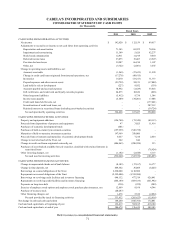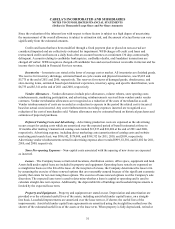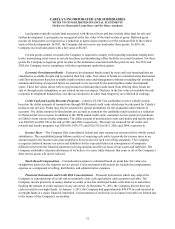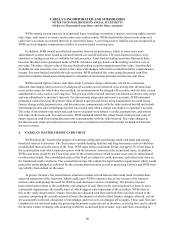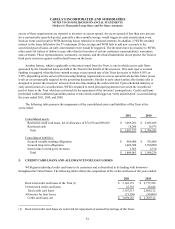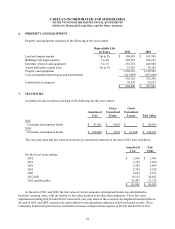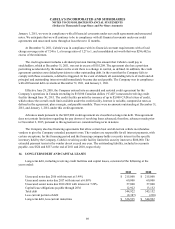Cabela's 2011 Annual Report Download - page 89
Download and view the complete annual report
Please find page 89 of the 2011 Cabela's annual report below. You can navigate through the pages in the report by either clicking on the pages listed below, or by using the keyword search tool below to find specific information within the annual report.79
CABELA’S INCORPORATED AND SUBSIDIARIES
NOTES TO CONSOLIDATED FINANCIAL STATEMENTS
(Dollars in Thousands Except Share and Per Share Amounts)
Effective June 16, 2011, the FASB issued ASU No. 2011-05, Comprehensive Income, requiring entities to
report components of other comprehensive income in either a single continuous statement or in two separate but
consecutive statements of net income and other comprehensive income. This ASU does not change the items
that must be reported in comprehensive income, how these items are measured, or when these items must be
classified to net income. ASU 2011-05 is effective for financial statements issued by the Company after January 1,
2012. Effective December 23, 2011, the FASB issued ASU 2011-12, which indefinitely deferred, pending further
deliberation by the FASB at a future date, the effective date of certain provisions of ASU 2011-05 relating to the
reclassification of items out of accumulated other comprehensive income. We will provide the required financial
reporting presentation in the Company’s first fiscal quarter of 2012.
Effective September 15, 2011, the FASB issued ASU No. 2011-08, Testing Goodwill for Impairment, which
gives companies testing goodwill for impairment the option of performing a qualitative assessment before
calculating the fair value of a reporting unit in step one of the goodwill impairment test. If companies determine,
based on qualitative factors, that the fair value of a reporting unit is more likely than not less than the carrying
amount, the two-step impairment test would be required. Otherwise, further testing would not be needed. ASU
2011-08 is effective for annual and interim goodwill impairment tests performed for fiscal years beginning after
December 15, 2011, or effective for the first quarter of 2012 for the Company, with early adoption permitted. The
value of our goodwill will not be affected by the adoption of the provisions of this ASU.
3. CHANGE IN ACCOUNTING PRINCIPLES - CONSOLIDATION OF CABELA’S MASTER CREDIT
CARD TRUST
The Company’s wholly-owned bank subsidiary, WFB, utilizes the Trust for the purpose of routinely selling
and securitizing credit card loans and issuing beneficial interest to investors. The accounting guidance on
consolidations in ASC Topic 810, and accounting for transfers of financial assets and the criteria for determining
whether to consolidate a variable interest entity in ASC Topic 860, resulted in the consolidation of the Trust
effective January 3, 2010. Prior to ASC Topics 810 and 860, the securitizations issued by the Trust qualified for
sales treatment under generally accepted accounting principles and, therefore, the Trust was excluded from the
Company’s consolidated financial statements.
As a result of the consolidation of the Trust, the Company’s retained earnings were adjusted for the
additional allowance for loan losses, the recording of the fair value of an interest rate swap relating to a variable
rate obligation of the Trust, and the derecognition of the interest-only strip (previously a component of retained
interests), net of tax effects. The Trust was consolidated on January 3, 2010, resulting in increases in total assets
of $2,154,540 and liabilities of $2,247,348, and a decrease in retained earnings and other comprehensive income
of $92,808, after tax. In 2010, we began reporting the results of operations of our Financial Services business in
a manner similar to our historical managed presentation for financial performance of the total managed portfolio
of credit card loans, excluding income derived from the changes in the valuation of our interest-only strip, cash
reserve accounts, and cash accounts associated with the securitized loans.
Prior to the consolidation of the Trust, WFB sold the majority of its credit card loans to a securitization trust
and recognized related gains or losses as a component of securitization income in Financial Services revenue. WFB
retains a minimum 20 day average of 5% of the interests in the securitization trust, known as a “transferor interest”
in the securitized loans, and ranks equal with the investor notes. Credit card loans classified as held for sale, which
included WFB’s transferor’s interest in securitized credit card loans, were carried at the lower of cost or market.
Net unrealized losses, if any, were recognized in income through a valuation allowance. Although WFB continued
to service the underlying credit card accounts and maintained the customer relationships, these securitization
transactions were treated as sales and the securitized loans were not included in the Company’s consolidated
balance sheet. Gains or losses were recognized at the time of sale, and depended in part on the carrying amount
assigned to the credit card loans sold, which was allocated between the assets sold and retained interest based on
their relative fair values at the date of transfer. WFB recognized a loss on sales totaling $4,157 for 2009.




